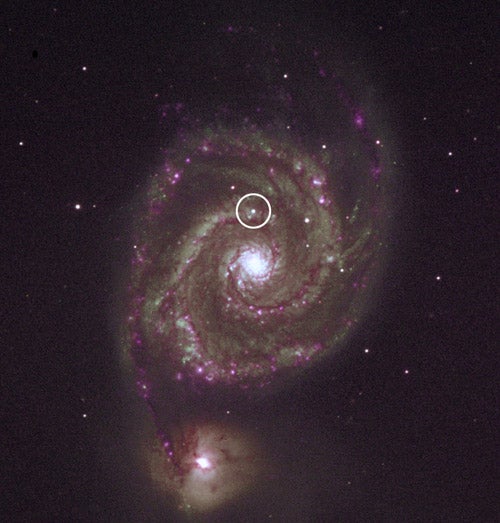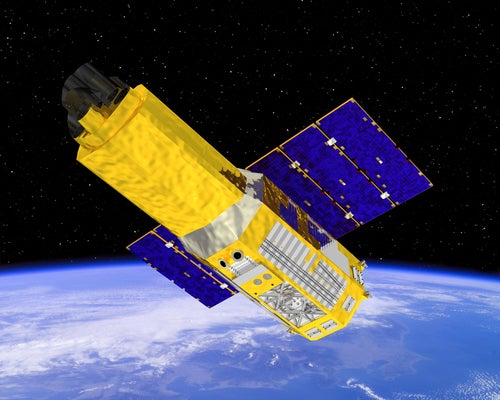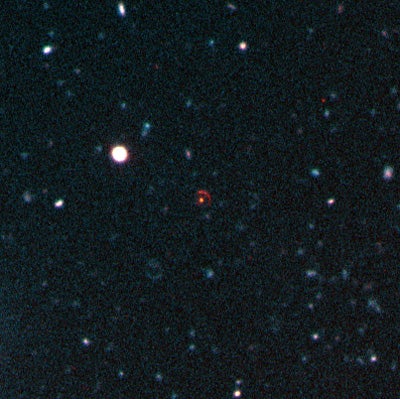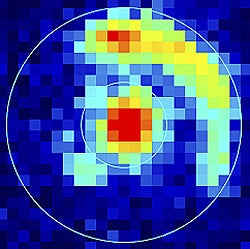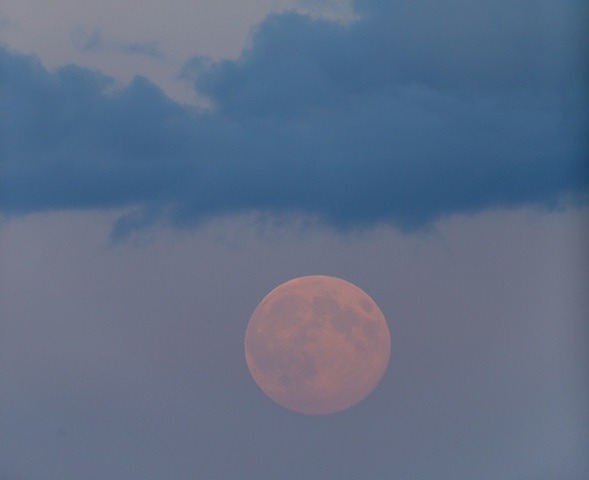High-school teachers observe new supernova
A group of high-school teachers took some of the earliest images of a new supernova in M51, the Whirlpool Galaxy. Eighteen teachers participating in the Teacher Leaders in Research Based Science Education (TLRBSE) program conducted by the National Optical Astronomy Observatory (NOAO) were learning how to take images in different colors with Kitt Peak’s WIYN 0.9-meter telescope June 30. At the time, they didn’t realize they had seen a new supernova.
A German amateur astronomer, Wolfgang Kloehr, discovered the supernova, SN 2005 CS, June 28. The supernova was confirmed by Lick Observatory June 30. After the discovery was announced, the teachers took more images with the WIYN 0.9m telescope and gathered spectroscopic data with Kitt Peak’s 2.1m telescope.
The purpose of the TLRBSE program is to train high-school science teachers in astronomical research, and this opportunity did just that. — Liz Kruesi
First lunar landing
Today marks the 36th anniversary of NASA’s Apollo 11 lunar landing. This was the first time humans landed on the Moon. The crew consisted of Command Module Pilot Michael Collins, Lunar Module Pilot Edwin “Buzz” Aldrin, and Commander Neil Armstrong, who became the first man to walk on the lunar surface.
While Collins orbited in the command module Columbia, Armstrong and Aldrin exited the lunar module Eagle and explored the Moon for nearly two and a half hours. The duo collected samples, shot photographs, and planted an American flag. They also left behind a tribute to the fallen Apollo 1 crew (Gus Grissom, Ed White, and Roger Chaffee) and a plaque reading, “Here men from the planet Earth first set foot upon the Moon. July 1969 A.D. We came in peace for all mankind.”
NASA would have 5 more successful manned missions to our closest neighbor, the last occurring in December 1972.
To hear audio of Neil Armstrong as he stepped onto the Moon, click here.
— Jeremy McGovern
Suzaku (née Astro-E2) reaches orbit
On July 10, the Japan Aerospace Exploration Agency (JAXA) successfully launched the Astro-E2 X-ray observatory on an M-V-6 rocket from Uchinoura Space Center in southern Japan.
Suzaku is Japan’s fifth X-ray satellite. A collaboration among Japanese universities and institutions and NASA’s Goddard Space Flight Center in Greenbelt, Maryland, the satellite is a reflight of Astro-E, which was lost February 2000 when its rocket failed to reach orbit. The key instrument is its X-ray Spectrometer (XRS), a pioneering detector capable of sensing the heat of individual X-ray photons. (For more on the XRS, see the July 1 entry below).
“Suzaku will fill a vital gap in our understanding of the X-ray universe,” says Goddard’s Richard Kelley, principal investigator for the U.S. contribution.
This highly anticipated mission complements NASA’s Chandra X-ray Observatory and the European Space Agency’s XMM-Newton spacecraft. Key targets for Suzaku include black holes, the million-degree gas from exploded stars, and gas between stars and galaxies. — Francis Reddy
NASA delayed the STS-114 launch today, just hours before space shuttle Discovery was to lift off.
Concerns over a failed fuel sensor lead to the postponement. Although the shuttle’s fuel tanks are full, the instrument incorrectly indicated a low level in an external tank. The orbiter’s engines shut down when fuel levels run low.
“There are long faces here in the control center and around the site. Everybody was so looking forward to flying today,” says NASA spokesman George Diller.
The earliest the next launch attempt could occur is Saturday, July 16. The current launch window closes July 31. Should Discovery take off, it will be the first shuttle launch since the fleet was grounded after the Columbia disaster in February 2003. — Jeremy McGovern
Far-out Einstein ring
Using the European Southern Observatory’s Very Large Telescope, Remi Cabanac of Chile’s Pontifical Catholic University in Santiago, Chile, and his European colleagues have found the most distant Einstein ring known.
An Einstein ring is a kind of cosmic mirage in which gravity from a foreground galaxy distorts light from a background galaxy into an arc. If the alignment is precise enough, the distant galaxy’s image warps into a complete ring. The new cosmic ring, dubbed FOR J0332-3557, arcs through 75 percent of a circle and lies in the southern constellation Fornax.
Such gravitational lensing allows astronomers to “weigh” the galaxy responsible for the mirage, and serves as a cosmic magnifying glass that lets astronomers see details in objects otherwise beyond the reach of current telescopes.
In the case of FOR J0332-3557, Cabanac’s team reports in the June III Astronomy & Astrophysics, the lensing galaxy seems to be an isolated, inactive elliptical perhaps 40,000 light-years across with a mass of 1 trillion Suns. The more distant object is a compact galaxy less than 1/6 this size, brimming with bright clusters from a recent burst of star formation.
The lensing galaxy lies about 8 billion light-years away and magnifies the background galaxy, which is 12 billion light-years away, almost 13 times. Thanks to the objects’ close alignment, astronomers can glimpse a galaxy as it was when the universe was only 12 percent of its present age. — Francis Reddy
Astro-E2 feels X-ray heat
When Japan’s new Astro-E2 X-ray observatory blasts into space this month, it will carry a pioneering detector. The satellite’s primary instrument is a high-resolution X-ray Spectrometer (XRS) developed jointly by NASA’s Goddard Space Flight Center in Greenbelt, Maryland, and the Japan Aerospace Exploration Agency’s (JAXA) Institute of Space and Astronautical Science (ISAS).
“Astro-E2 will showcase an entirely new technology,” says Anne Kinney, director of the Universe Division in NASA’s Science Mission Directorate. “This is the highly anticipated complement to NASA’s Chandra X-ray Observatory and Europe’s XMM-Newton. Scientists around the world eagerly await the launch.”
The XRS, which is cooled to approximately –460º Fahrenheit (–273º Celsius) measures heat released by the individual X-ray photons it absorbs. Each particle will raise the device’s temperature by just thousandths of a degree. This new technique lets the XRS measure high X-ray energies with a precision about 10 times greater than that of previous sensors.
Astro E-2 carries five other X-ray detecting instruments, built in collaboration between Japanese institutions and the Massachusetts Institute of Technology. The spacecraft is scheduled for launch into Earth orbit July 6 from Japan’s Uchinoura Space Center in Kagoshima. It’s expected to return data for 5 years. — Francis Reddy
Olivine from a supernova
Scientists have discovered pristine grains of the mineral olivine they say formed in an ancient supernova explosion. Scott Messenger and Lindsay Keller NASA’s Johnson Space Center in Houston, and Dante Lauretta of the University of Arizona’s Lunar and Planetary Laboratory, Tucson, found the grains among extraterrestrial dust snatched from Earth’s upper atmosphere by a high-flying NASA research aircraft.
Scientists have found evidence a supernova produced radioactive atoms a few million years before our Sun formed, although no one knows if the explosion helped kick-start our solar system. Messenger’s team used a new type of ion microprobe to measure oxygen isotopes in these unusual grains. The researchers then used well-known models of supernova structure to see if the grain could have condensed directly from a supernova’s cooling gaseous envelope.
“The supernova grains have oxygen isotopic ratios that have never been seen before in meteorites or comet dust, but are predicted in astrophysical models of supernova explosions,” Messenger says. The team published its results in this week’s Science.
According to Lauretta, his chemical analysis matched the grain’s actual composition “dead on,” while Messenger’s isotope ratios enabled the team to detail the grain’s natural history.
The scientists say the mineral comes from magnesium, iron, and silicon mixed when a star about 15 times the Sun’s mass collapsed and exploded. The olivine crystallized when the supernova’s expanding gas shell cooled enough to form dust. Many olivine grains stuck together to form a submicron-size rock.
The microscopic rock floated through the interstellar medium for millions of years. It was swept eventually into a cold, dust cloud, and coated with a veneer of organic matter. When this cloud collapsed to form our solar system 4.5 billion years ago, the grain found its way into a comet or asteroid. There the tiny rock remained until a comet jet or collision ejected it into space, where Earth could sweep it up for scientists to collect. — Francis Reddy

